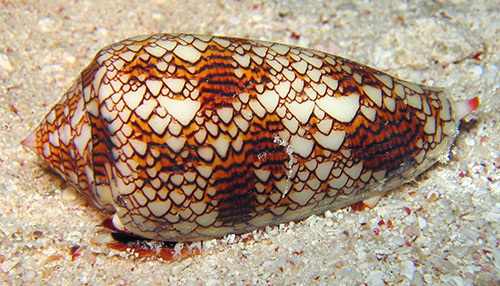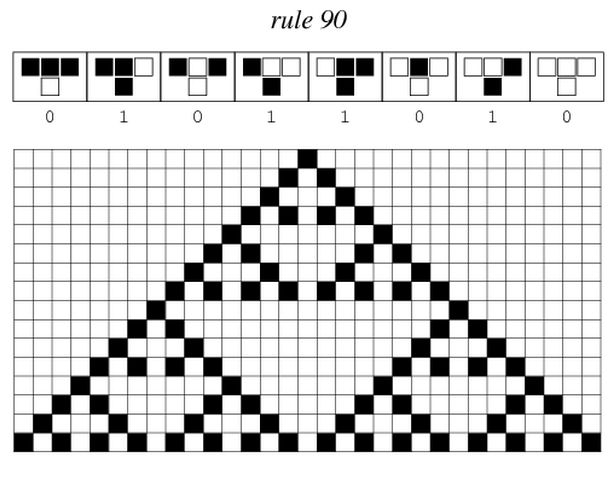|
|
| Line 2: |
Line 2: |
| | You might be wondering where these patterns on snea snail shells come from. What if they would come from a simple rule, followed by all cells on the shell ? | | You might be wondering where these patterns on snea snail shells come from. What if they would come from a simple rule, followed by all cells on the shell ? |
| | [[File:ETH Zurich Rule 90.PNG|700px]] | | [[File:ETH Zurich Rule 90.PNG|700px]] |
| - |
| |
| - | <html>
| |
| - | <head>
| |
| - | <title>Automaton Explorer</title>
| |
| - | <script type="text/javascript" src="../../protovis-d3.2.js"></script>
| |
| - | <script type="text/javascript" src="../jquery-1.4.2.min.js"></script>
| |
| - | <script type="text/javascript" src="jquery-ui-1.8rc3.custom.min.js"></script>
| |
| - | <script type="text/javascript" src="cell.js"></script>
| |
| - | <link type="text/css" href="ui-lightness/jquery-ui-1.8rc3.custom.css" rel="stylesheet"/>
| |
| - | <link type="text/css" href="../../tests/style.css" rel="stylesheet"/>
| |
| - | <style type="text/css">
| |
| - | .ui-slider {
| |
| - | font-size: 10px;
| |
| - | width: 300px;
| |
| - | margin-top: 5px;
| |
| - | }
| |
| - | sup, sub {
| |
| - | line-height: 0;
| |
| - | }
| |
| - | .ui-state-focus {
| |
| - | outline: none;
| |
| - | }
| |
| - | #slider {
| |
| - | width: 300px;
| |
| - | display: inline-block;
| |
| - | margin-left: 10px;
| |
| - | margin-right: 10px;
| |
| - | }
| |
| - | </style>
| |
| - | </head>
| |
| - | <body>
| |
| - | <h3>Automaton Explorer</h3>
| |
| - | <div style="width:8in;">
| |
| - | rule: <span id="slider"></span><span id="rule">30</span>
| |
| - | <span style="float:right;">
| |
| - | start: <input type="radio" checked id="point" name="start" value="point">
| |
| - | <label for="point">point</label>
| |
| - | <input type="radio" id="random" name="start" value="random">
| |
| - | <label for="random">random</label>
| |
| - | </span>
| |
| - | </div><p>
| |
| - | <script type="text/javascript+protovis">
| |
| - | var h = 128,
| |
| - | w = h << 1,
| |
| - | start = "point",
| |
| - | rule = 30;
| |
| - | var vis = new pv.Panel()
| |
| - | .width(w * 3)
| |
| - | .height(h * 3)
| |
| - | .top(40);
| |
| - | vis.add(pv.Panel)
| |
| - | .data(pv.range(8))
| |
| - | .right(function(i) (i + .5) * w * 3 / 8)
| |
| - | .top(-35)
| |
| - | .event("mousedown", function(i) ($("#rule").html(rule ^= 1 << i), vis))
| |
| - | .add(pv.Bar)
| |
| - | .top(10)
| |
| - | .right(-5)
| |
| - | .width(10)
| |
| - | .height(10)
| |
| - | .title(function(j, i) "Toggle bit " + i + ".")
| |
| - | .strokeStyle("#bbb")
| |
| - | .fillStyle(function(i) rule >> i & 1 ? "#000" : "#fff")
| |
| - | .add(pv.Bar)
| |
| - | .data(pv.range(3))
| |
| - | .top(0)
| |
| - | .right(function(i) i * 10 - 15)
| |
| - | .fillStyle(function(i, j) j >> i & 1 ? "#000" : "#fff");
| |
| - | vis.add(pv.Image)
| |
| - | .def("cell", cell)
| |
| - | .imageWidth(w)
| |
| - | .imageHeight(h)
| |
| - | .image(pv.colors("#fff", "#000").by(function(x, y) this.cell()[y][x]));
| |
| - | vis.render();
| |
| - | $(slider).slider({
| |
| - | min: 1, value: 30, max: 255, slide: function(e, ui) {
| |
| - | $("#rule").html(rule = ui.value);
| |
| - | vis.render();
| |
| - | }
| |
| - | });
| |
| - | $([point, random]).change(function() {
| |
| - | start = this.value;
| |
| - | vis.render();
| |
| - | });
| |
| - | </script>
| |
| - | <p>From <a href="http://mathworld.wolfram.com/CellularAutomaton.html">MathWorld</a>:
| |
| - | "A cellular automaton is a collection of 'colored' cells on a grid of
| |
| - | specified shape that evolves through a number of discrete time steps
| |
| - | according to a set of rules based on the states of neighboring cells." This
| |
| - | example explores binary, nearest-neighbor, one-dimensional automata, of
| |
| - | which there are 256 (2<sup>8</sup>) possible rules. The eight possible
| |
| - | outcomes for the current rule are shown across the top; click to toggle the
| |
| - | selected bit.
| |
| - | </body>
| |
| - |
| |
| - | <script>
| |
| - | /** Depends on globals: rule, w, h, mode. */
| |
| - | function cell() {
| |
| - | var d = pv.range(h).map(function() {
| |
| - | return pv.range(w).map(function() { return 0; });
| |
| - | }),
| |
| - | r = pv.range(8).map(function(i) {
| |
| - | return rule >> i & 1;
| |
| - | });
| |
| - | if (start == "point") {
| |
| - | d[0][w >> 1] = 1;
| |
| - | } else {
| |
| - | for (var x = 0; x < w; x++) {
| |
| - | d[0][x] = cell.random(x);
| |
| - | }
| |
| - | }
| |
| - | for (var y = 1; y < h; y++) {
| |
| - | var p = d[y - 1], c = d[y];
| |
| - | for (var x = 0; x < w; x++) {
| |
| - | c[x] = r[p[x - 1] << 2 | p[x] << 1 | p[x + 1]];
| |
| - | }
| |
| - | }
| |
| - | return d;
| |
| - | }
| |
| - | cell.$random = {};
| |
| - | /** Caches random output to make exploration deterministic. */
| |
| - | cell.random = function(i) {
| |
| - | return i in cell.$random ? cell.$random[i]
| |
| - | : (cell.$random[i] = Math.random() < .5 ? 0 : 1);
| |
| - | };
| |
| - | </script>
| |
| - |
| |
| - | </html>
| |
 You might be wondering where these patterns on snea snail shells come from. What if they would come from a simple rule, followed by all cells on the shell ?
You might be wondering where these patterns on snea snail shells come from. What if they would come from a simple rule, followed by all cells on the shell ?

 "
"